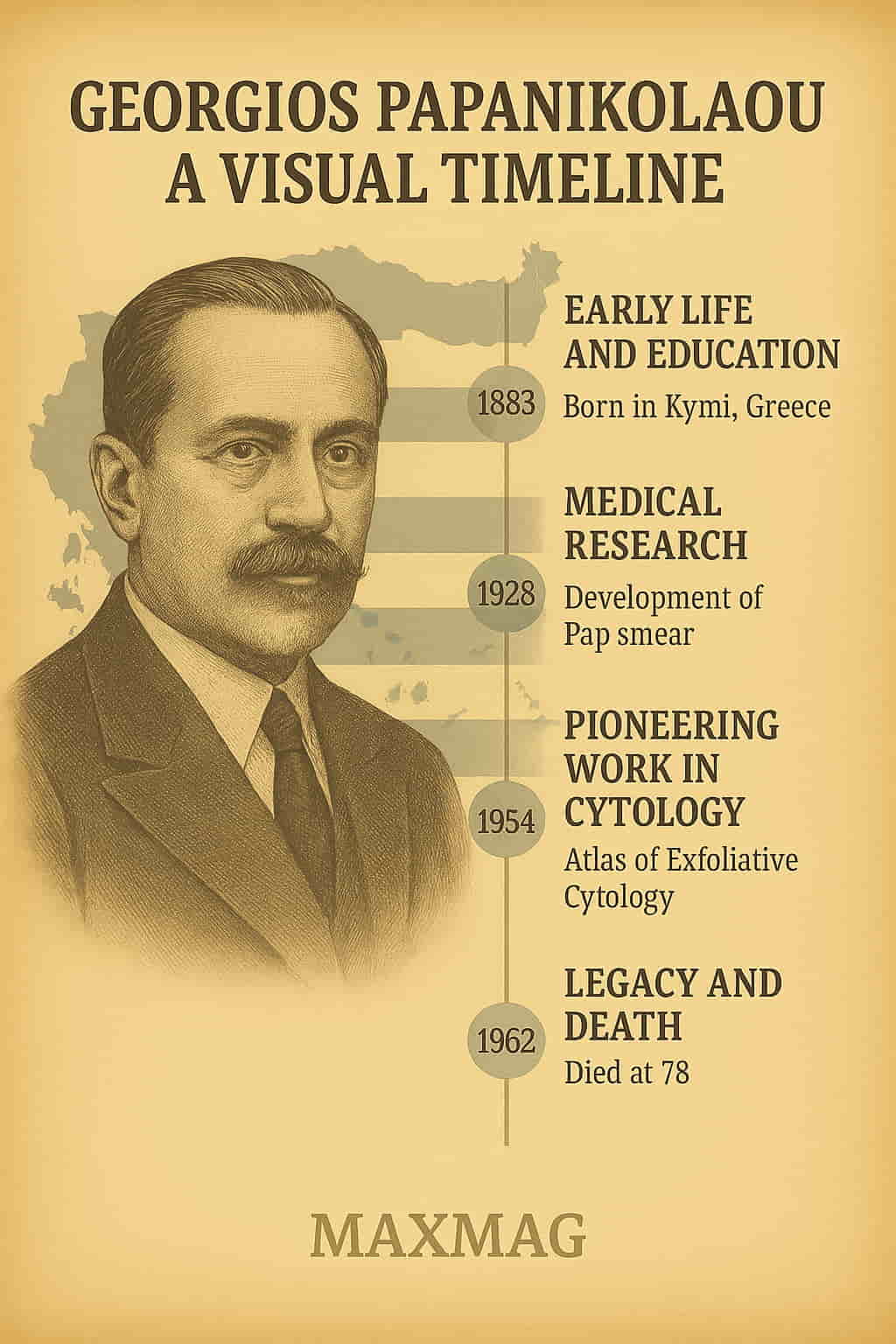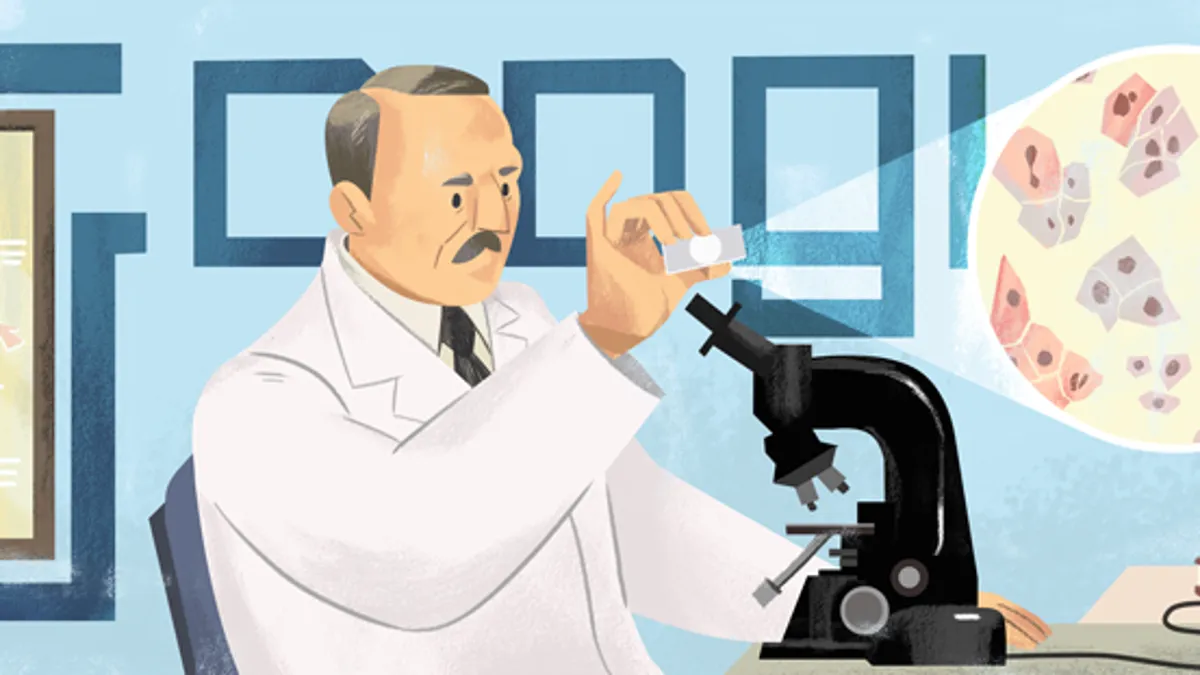
Few names in medical history carry the quiet yet transformative weight of Georgios Papanikolaou, the Greek physician whose development of the Pap smear has become a global standard in cancer prevention. While his scientific discoveries have undoubtedly saved millions of lives, his story is not merely one of invention — it is also one of grit, exile, partnership, and enduring commitment to human health.
This detailed Georgios Papanikolaou biography not only honors his role in revolutionizing gynecological science but also sheds light on his intellectual roots, his overlooked sacrifices, and the legacy that continues to empower women’s health worldwide.
A Humble Beginning in Greece
Georgios Papanikolaou was born on May 13, 1883, in the quiet village of Kymi on the island of Euboea, Greece. His father, Nikolaos, was a prominent doctor and politician. From a young age, Georgios was immersed in a world of learning, language, and healing. His early education was multidisciplinary: he studied humanities, philosophy, and music — playing the violin with near-professional skill.
Yet the allure of medicine, inherited from his father, ultimately prevailed. He earned his medical degree from the University of Athens in 1904. However, Papanikolaou was not content with clinical practice alone. He longed to understand life at its most microscopic levels.
Formative Years in Europe
After serving as a physician in the Greek Army from 1904 to 1906, Papanikolaou pursued advanced scientific studies in Germany. He studied at the University of Jena, where he was influenced by the Darwinist and biologist Ernst Haeckel. It was there that he earned his PhD in zoology in 1910, focusing on the embryological development of aquatic life.
This period helped him cultivate a scientific mind deeply rooted in observation, biology, and cell theory — the very tools he would later use to change cancer diagnostics forever.
Love and Partnership: Mary Papanikolaou
In 1913, Georgios married Andromachi Mavroyeni, affectionately known as Mary. Their marriage was not merely romantic; it was also a scientific partnership. Together, they left Greece in 1913, seeking better opportunities in the United States. Their early years in New York City were steeped in hardship.
Mary worked in department stores sewing buttons while Georgios played the violin at restaurants and sold rugs door-to-door. Despite the challenges, they supported each other unwaveringly. Mary eventually became his full-time lab assistant and volunteered as a test subject for his experiments for more than two decades. Her role in his research is widely seen as critical — and often underappreciated.
Entering American Medicine
In 1914, Papanikolaou secured a modest research position at the New York Hospital and later at Cornell University Medical College, where he would remain for most of his career. Though he was underpaid and marginalized early on, he poured his energy into cytological research — the study of individual cells — while maintaining a humble lifestyle.
His primary interest was reproductive physiology. Initially, he studied the menstrual cycle in guinea pigs by collecting and analyzing vaginal cells. This seemingly simple experiment was the seed of a revolutionary idea.
Discovering the Pap Smear: An Accidental Revolution
By 1928, Georgios had begun applying his methods to human subjects — particularly Mary, who allowed him to take daily samples from her cervix. In analyzing these samples, Papanikolaou made a remarkable observation: abnormal cells appeared in women with uterine or cervical cancer, distinguishable even in early stages.
He presented his findings in a paper that year, but the medical community was largely dismissive. Many believed that cancer could not be detected so easily or so early. Papanikolaou, unfazed, continued refining the method. Over the next 15 years, he published dozens of studies and co-wrote the landmark 1943 book Diagnosis of Uterine Cancer by the Vaginal Smear with pathologist Herbert Traut.
This test — eventually known as the Pap smear — became the first practical method for detecting cervical cancer early, long before symptoms appeared.
Global Impact of the Pap Smear
Cervical cancer had historically been one of the most fatal diseases among women. The introduction of the Pap smear marked a sea change: mortality rates dropped by over 70% in countries where the test was implemented widely.
Beyond its diagnostic value, the test symbolized a new era in preventive medicine. It allowed healthcare professionals to intervene before cancer could advance, giving women power over their own reproductive health. In many ways, Georgios Papanikolaou helped lay the foundation for modern gynecology and public health screening.
Honors, Recognition, and a Missing Nobel
Papanikolaou’s contributions did not go unnoticed — but they were not always honored in the way they deserved.
In 1950, he received the Albert Lasker Award for Clinical Medical Research, one of the most prestigious accolades in American medicine. He was also made an honorary member of various scientific academies and received honorary doctorates from institutions across Europe and the United States.
However, he was nominated five times for the Nobel Prize in Medicine but never won. Some speculate that the Nobel Committee was hesitant to reward a diagnostic test rather than a “cure,” while others suggest that the recognition was delayed too long for it to be awarded posthumously.
Final Years and the Miami Institute
In 1961, Papanikolaou was offered the chance to head a new cancer research center in Miami, Florida — now named the Papanicolaou Cancer Research Institute. He accepted the offer, relocated, and began organizing the institute’s programs and staff. But just months into the endeavor, he died of a sudden heart attack on February 19, 1962, at the age of 78.
His death shocked the medical world. Tributes poured in from across the globe. Mary, ever loyal, continued advocating for her husband’s legacy until her own passing in 1982.
How the Pap Smear Works Today
Modern Pap smear procedures still rely on the principles Georgios developed. A small brush or spatula collects cervical cells, which are then preserved and examined under a microscope. Today, it’s often combined with HPV testing, further increasing accuracy and early detection.
More than 60 million Pap tests are performed annually in the U.S. alone, according to the American Cancer Society. Worldwide, the test is responsible for saving millions of lives and continues to be a key component of women’s annual health screenings.
The Cytological Revolution
Georgios Papanikolaou did not just invent a test; he founded a field: cytopathology. This branch of pathology, which focuses on disease detection at the cellular level, now includes techniques for diagnosing breast, thyroid, and lung cancers. His early atlases — especially the 1954 Atlas of Exfoliative Cytology — remain classics in medical literature.
His research techniques and publications influenced a generation of pathologists and fundamentally changed medical education, diagnostic protocols, and women’s healthcare policy.
Georgios Papanikolaou Biography and Gender Equity in Medicine
It is impossible to ignore the social implications of Georgios’s work. At a time when female reproductive health was understudied and often taboo, his contributions legitimized it in medical discourse.
Moreover, by designing a non-invasive, affordable, and effective screening tool, he empowered women with greater bodily autonomy and long-term health security. His life’s work helped shift healthcare from reaction to prevention, creating systems that prioritized routine check-ups and proactive measures.
Honors and Cultural Legacy
Papanikolaou’s legacy lives not only in hospitals and clinics but in culture and education:
-
His likeness has appeared on Greek postage stamps.
-
His story has been featured in books, documentaries, and lectures.
-
In 2019, Google honored him with a Doodle on his 136th birthday.
-
Statues and busts in Greece and the U.S. immortalize his contribution to science.
In addition, schools and research centers in Greece are named after him, including the “Georgios Papanikolaou” Hospital in Thessaloniki, one of the country’s largest public hospitals.
📘 Georgios Papanikolaou Biography in Focus
This comprehensive Georgios Papanikolaou biography offers more than a look into a scientist’s life — it captures a narrative of relentless passion, personal sacrifice, and global impact. From the sleepy hills of Kymi to the bustling labs of Cornell, he carved out a career that defied academic politics, financial hardship, and institutional resistance.
His story is not merely about invention, but about devotion to humanity. His courage to continue working on a ridiculed theory for 15 years — without funding or acclaim — embodies the best of scientific integrity.
FAQs
1. What was Georgios Papanikolaou known for?
He was the developer of the Pap smear, a test used to detect cervical cancer in women. His work revolutionized early cancer diagnosis.
2. Where did Papanikolaou study and work?
He studied in Greece and Germany and later worked primarily at Cornell University and New York Hospital. He ended his career in Miami.
3. Why didn’t he win the Nobel Prize?
Despite five nominations, he never received it — possibly due to the committee’s hesitation to award diagnostic tools rather than therapeutic breakthroughs.
4. What is cytopathology?
It is the study of disease through the examination of cells — a field founded by Papanikolaou’s work.
5. Is the Pap smear still used today?
Yes. It remains one of the most effective screening methods for cervical cancer and is often paired with HPV testing.
6. What role did Mary Papanikolaou play?
She was his lab partner and longtime test subject, playing a crucial and often unrecognized role in the development of the Pap smear.







